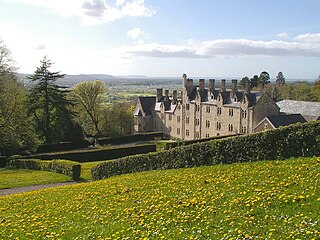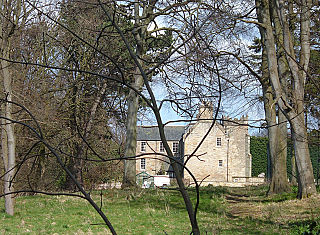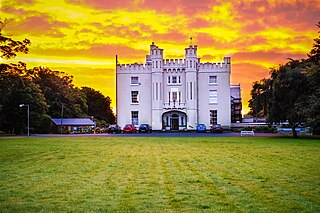
The Church of Saint Andrew on the Quirinal is a Roman Catholic titular church in Rome, Italy, built for the Jesuit seminary on the Quirinal Hill.

St Ignatius College is a Catholic voluntary aided secondary school for boys aged 11–18 in Enfield, London, England, founded by the Society of Jesus in 1894 and completely moved to its present site by 1987. It was a grammar school until 1968, only accepting boys who had passed the Eleven plus exam. Former students include Alfred Hitchcock, George Martin, and Cardinal John Heenan.
St Stanislaus College was a Jesuit boys boarding school, novitiate and philosophy school, in Tullabeg, Rahan, County Offaly. St Carthage founded a monastery of 800 monks there in 595 before founding his monastery in Lismore. The Presentation Sisters also have a convent in Rahan, Killina, which was founded at the same time as the Jesuits founded St Stanislaus College.
Joseph Patrick Michael Cassidy FRSA was a Canadian-born priest in the Church of England, theologian and academic. He was formerly a Roman Catholic priest and Jesuit. He was Principal of St Chad's College at Durham University, England and a member of the university's theology department. He was also a non-residentiary canon of Durham Cathedral.

St. Stanislaus Seminary is a former Society of Jesus (Jesuits) seminary that was founded in 1823 on the outskirts of Florissant, Missouri within the current municipal limits of Hazelwood, Missouri. It was the longest continuously operated Jesuit novitiate in the United States.

St Beuno's Jesuit Spirituality Centre, known locally as St Beuno's College, is a spirituality and retreat centre in Tremeirchion, Denbighshire, Wales. It was built in 1847 by the Jesuits, as a theology college. During the 1870s the Victorian poet Gerard Manley Hopkins studied there. Since 1980, it has been a spirituality and retreat centre. Standing on the Clwydian Range, the front of the building faces west towards Snowdonia and overlooks the Vale of Clwyd. The building became a Grade II* listed building and a Welsh Historic Monument in 2002.

Rainhill Hall or Loyola Hall is a Grade II listed country house built in the 19th century in Rainhill, Merseyside, England, by Bartholomew Bretherton. It is situated on the Warrington Road, next to St Bartholomew's Church. From 1923 to 2014, it was a retreat house run by the Society of Jesus. From 2017, it has been a hotel and wedding venue owned by Signature Living.

Woodhall House is a Scottish mansion house, first recorded in 1707. It was also an institution run by the Society of Jesus in the late 20th century. It is situated off Woodhall Road in the Juniper Green area of Edinburgh, Scotland and is a category B listed building.
Ignatius Scoles SJ was a Roman Catholic Jesuit priest, architect and writer. He designed churches and civic buildings and was the son of Joseph John Scoles.

Manresa House is a retreat centre run by the Society of Jesus in the Dollymount area of Clontarf in Dublin, near Saint Anne's Park. In the 19th century it was home to Robert Warren and Arthur Guinness, and it is a protected structure.

Holy Rosary Church is a Roman Catholic Parish church in Guelph, Ontario, Canada. It was originally part of the parish of Church of Our Lady Immaculate, Guelph. It was founded in 1956. Since 2001, it has been administered by the Society of Jesus.

St. Ignatius Church is a Roman Catholic Parish church in Notre-Dame-de-Grâce, Montreal West, Quebec. It was founded by the Society of Jesus in 1917 as an English-speaking parish. It is next to Loyola High School and the Loyola Campus of Concordia University.

Manresa Jesuit Spiritual Renewal Centre is a centre for Ignatian spirituality run by the Society of Jesus in Pickering, Ontario. It was founded in 1924 and was built in 1945. It is situated next to Pine Ridge Secondary School just off Finch Avenue in north Pickering.

Manresa Spirituality Centre or Villa Manresa is a centre for Ignatian spirituality in the Sainte-Foy area of Quebec City. It was founded in 1891 by the Society of Jesus originally on Chemin Sainte-Foy. In 1921, it moved close to Parc des Braves. It is now situated on Louis Fréchette next to St. Charles Garnier College
Villa Loyola is a centre in Ignatian spirituality run by the Society of Jesus in Greater Sudbury, Ontario, Canada. It is the only Canadian French-speaking Jesuit centre outside of Quebec. As well serving as a retreat centre it is also an ecumenical and interfaith conference centre. It is situated on the shore of Long Lake off Municipal Road 80 to the south of Sudbury's urban core.

Parkstead House, formerly known as Manresa House and Bessborough House, is a neo-classical Palladian villa in Roehampton, London, built in the 1760s. The house and remaining grounds are now Whitelands College, part of the University of Roehampton. It is situated on Holybourne Avenue, off Roehampton Lane, next to the Richmond Park Golf Course in the London Borough of Wandsworth. In 1955 it was designated Grade I on the National Heritage List for England.

Loyola House or its full name Loyola House Retreat and Training Centre is a Jesuit spirituality centre in Guelph, Ontario. It moved to Guelph in 1964 and was the centre of a renewal in Ignatian spirituality in the 1970s. It is within the grounds of the Ignatius Jesuit Centre situated on Woolwich Street to the west of Riverside Park. In the 1960s and 1970s it was the centre of a significant shift in Ignatian spirituality.

The Guelph Raid was an incident that occurred at the St. Stanislaus Novitiate in Guelph, Ontario, in 1918. The novitiate was attended by the son of Charles Doherty, the Justice Minister of Canada. Canadian military officers surrounded it attempting to enforce the Military Service Act, causing a royal commission to be appointed by the Parliament of Canada in April 1919.

La Pairelle or its full name Centre Spirituel Ignatien La Pairelle is a Catholic spirituality and retreat centre in Wépion, Namur, Belgium. It was built in 1932 by the Jesuits and was designed by Albert Ghequière with a chapel built in the Gothic Revival style. It is located off Rue Marcel Lecomte on a hill in the district of Wépion in Namur, overlooking the River Meuse. It is the only French-speaking Jesuit retreat centre in Belgium.

























